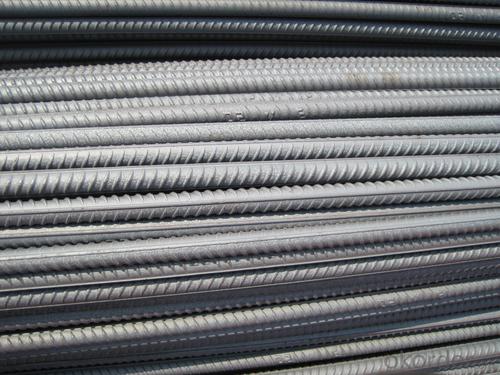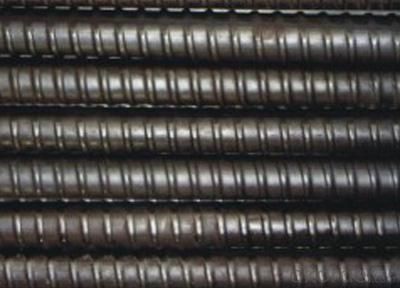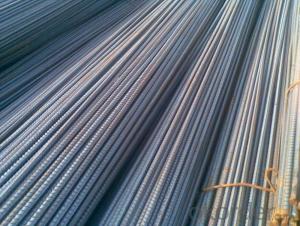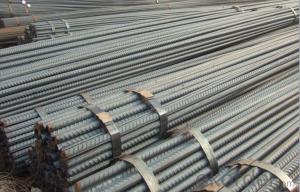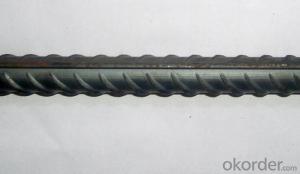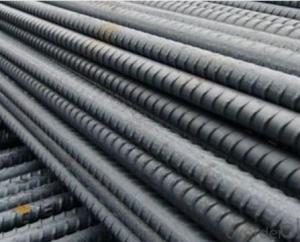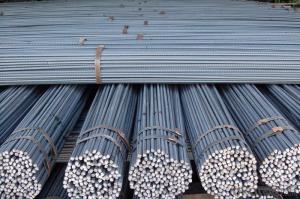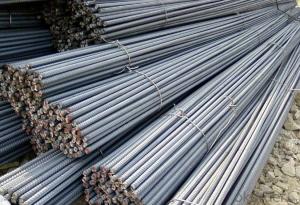Hot Rolled Carbon Steel Rebar 16-25mm with High Quality
- Loading Port:
- China Main Port
- Payment Terms:
- TT or LC
- Min Order Qty:
- 25 m.t.
- Supply Capability:
- 10000 m.t./month
OKorder Service Pledge
OKorder Financial Service
You Might Also Like
Product Description:
OKorder is offering Hot Rolled Carbon Steel Rebar 16-25mm with High Quality at great prices with worldwide shipping. Our supplier is a world-class manufacturer of steel, with our products utilized the world over. OKorder annually supplies products to European, North American and Asian markets. We provide quotations within 24 hours of receiving an inquiry and guarantee competitive prices.
Product Applications:
Hot Rolled Carbon Steel Rebar 16-25mm with High Quality is widely used in buildings, bridges, roads and other engineering construction. Big to highways, railways, bridges, culverts, tunnels, public facilities such as flood control, dam, small to housing construction, beam, column, wall and the foundation of the plate, deformed bar is an integral structure material. With the development of world economy and the vigorous development of infrastructure construction, real estate, the demand for deformed bar will be larger and larger..
Product Advantages:
OKorder's Hot Rolled Carbon Steel Rebar 16-25mm with High Quality are durable, strong.packed and suitable for construction
Main Product Features:
· Premium quality
· Prompt delivery & seaworthy packing (30 days after receiving deposit)
· Can be recycled and reused
· Mill test certification
· Professional Service
· Competitive pricing
Product Specifications:
Manufacture: Hot rolled
Grade: HRB335 HRB400 BS4449 Grade460 ASTM Grade40 Grade60
Certificates: ISO, SGS, BV, CIQ
Length:6m 8m 9m 12m
Packaging: Export packing, packed by coil
FAQ:
Q1: Why buy Materials & Equipment from OKorder.com?
A1: All products offered byOKorder.com are carefully selected from China's most reliable manufacturing enterprises. Through its ISO certifications, OKorder.com adheres to the highest standards and a commitment to supply chain safety and customer satisfaction.
Q2: How do we guarantee the quality of our products?
A2: We have established an advanced quality management system which conducts strict quality tests at every step, from raw materials to the final product. At the same time, we provide extensive follow-up service assurances as required.
Q3: How soon can we receive the product after purchase?
A3: Within three days of placing an order, we will begin production. The specific shipping date is dependent upon international and government factors, but is typically 7 to 10 workdays.
Q4: How many tons per bundle?
A4: Around 2-3tons
Q5: How to avoid the rust after deliver the goods to the loading port?
A5: We will keep the goods at the port covered with water-proof material
Q6: What is the chemical composition and physical properties of HRB400?
A6:
Grade | Technical data of the original chemical composition (%) | ||||||
C | Mn | Si | S | P | V | ||
HRB400 | ≤0.25 | ≤1.60 | ≤0.80 | ≤0.045 | ≤0.045 | 0.04-0.12 | |
Physical capability | |||||||
Yield Strength (N/cm²) | Tensile Strength (N/cm²) | Elongation (%) | |||||
≥400 | ≥570 | ≥14 | |||||
Q7:What is the weight per meter for the common sizes:
A7:
Diameter(mm) | Section area (mm²) | Mass(kg/m) | Weight of 12m bar(kg) |
10 | 78.54 | 0.617 | 7.404 |
12 | 113.1 | 0.888 | 10.656 |
14 | 153.9 | 1.21 | 14.52 |
16 | 201.1 | 1.58 | 18.96 |
18 | 254.5 | 2.00 | 24 |
20 | 314.2 | 2.47 | 29.64 |
22 | 380.1 | 2.98 | 35.76 |
25 | 490.9 | 3.85 | 46.2 |
28 | 615.8 | 4.83 | 57.96 |
32 | 804.2 | 6.31 | 75.72 |
36 | 1018 | 7.99 | 98.88 |
40 | 1257 | 9.87 | 118.44 |
50 | 1964 | 15.42 | 185.04 |
Images:
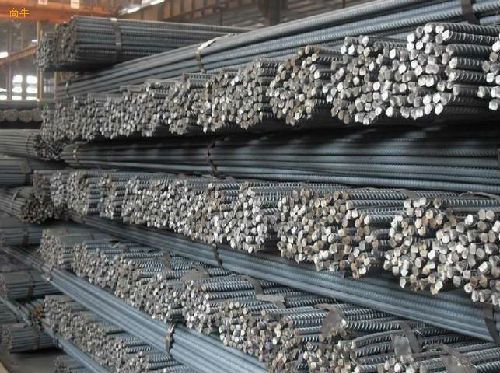
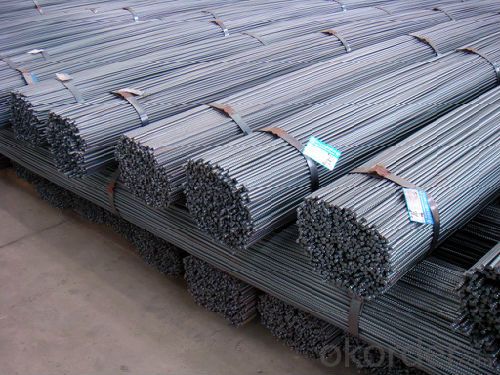
- Q: How do steel rebars resist corrosion?
- Steel rebars resist corrosion through a process called passivation. When the steel is exposed to air and moisture, a thin layer of iron oxide forms on its surface, which acts as a protective barrier against further corrosion. This layer, also known as rust, prevents oxygen and moisture from reaching the inner layers of steel, thereby preventing further oxidation. Additionally, steel rebars are often coated with materials such as epoxy or zinc to provide an extra layer of protection against corrosion. These coatings act as a physical barrier between the steel and the environment, preventing contact with corrosive elements. Regular maintenance, such as cleaning and applying protective coatings, can also help to extend the lifespan of steel rebars and prevent corrosion.
- Q: What is the process of removing steel rebars from concrete structures?
- The process of removing steel rebars from concrete structures involves several steps to ensure the safe and efficient removal of these reinforcement bars. 1. Assessment: Before starting the removal process, a thorough assessment of the concrete structure needs to be conducted. This includes evaluating the type and condition of the rebars, the integrity of the surrounding concrete, and any potential risks or obstacles that may affect the removal process. 2. Preparation: Once the assessment is completed, necessary preparations are made to ensure the safety of the workers and the surrounding environment. This may involve wearing personal protective equipment, setting up barricades or safety barriers, and securing the area to prevent any accidents or injuries. 3. Cutting: The next step is to cut the steel rebars. This can be done using various techniques such as oxyacetylene cutting, saw cutting, or using specialized cutting tools like rebar cutters or shears. The cutting method used depends on the size and thickness of the rebars, as well as the accessibility of the area. 4. Extraction: After the rebars are cut, they need to be extracted from the concrete structure. This can be done manually using pry bars or mechanical methods such as using cranes, excavators, or hydraulic breakers. The extraction process should be done carefully to avoid damaging the surrounding concrete or causing any structural instability. 5. Cleaning and Restoration: Once the rebars are removed, the area needs to be cleaned of any debris or leftover material. This is important to ensure a safe working environment for any subsequent construction or renovation work. Additionally, any damage caused to the concrete structure during the removal process should be repaired or restored to maintain its structural integrity. It is important to note that the process of removing steel rebars from concrete structures should be carried out by trained professionals with expertise in construction and demolition. It is also essential to comply with local regulations and safety guidelines to prevent accidents, minimize environmental impact, and preserve the integrity of the concrete structure.
- Q: How do steel rebars affect the overall cost-effectiveness of a structure?
- Steel rebars can greatly enhance the cost-effectiveness of a structure by providing added strength and durability. Their use reduces the need for excessive concrete, leading to cost savings in material and construction time. Additionally, the longevity and resistance to corrosion offered by steel rebars can result in reduced maintenance and repair expenses over the lifespan of the structure.
- Q: How do steel rebars improve the ductility of a structure?
- Steel rebars improve the ductility of a structure by providing reinforcement and enhancing its ability to withstand tensile forces. The presence of rebars within concrete or other structural materials allows them to better absorb and distribute stress, preventing brittle failure and promoting flexural strength.
- Q: What are the recommended practices for welding steel rebars?
- To achieve a strong and reliable bond when welding steel rebars, certain recommended practices should be followed. These practices encompass: 1. Cleanliness: Prior to welding, it is crucial to ensure that the surfaces of the rebars are clean and devoid of any contaminants such as dirt, rust, or grease. Wire brushing or sandblasting can be employed to achieve a thorough cleaning. 2. Preheating: Preheating the steel rebars before welding can minimize the risk of cracking and enhance the weld's quality. The preheating temperature should be determined based on the rebar's thickness and the specific welding procedure being used. 3. Welding process: There are various welding processes suitable for steel rebars, with shielded metal arc welding (SMAW) and gas metal arc welding (GMAW) being the most commonly used. The choice of process is influenced by factors like rebar size, project requirements, and local regulations. 4. Electrodes and filler material: It is crucial to select electrodes and filler materials that are suitable for achieving a strong and durable weld. It is recommended to use materials that match the rebar's carbon content and strength. 5. Welding technique: Employing proper welding techniques, such as maintaining a consistent arc length, controlling the travel speed, and ensuring proper joint alignment, is essential for producing high-quality welds. 6. Post-weld treatment: After welding, it is important to allow the welded rebars to cool gradually to prevent thermal stress. Performing post-weld treatments, such as stress relieving, can also help minimize residual stresses and improve the weld's integrity. 7. Inspection and testing: Regular visual inspections and non-destructive testing, such as ultrasonic or magnetic particle testing, should be conducted to ensure the quality and integrity of the welded rebar joints. 8. Compliance with codes and standards: It is vital to always adhere to the relevant welding codes and standards specified by local authorities or project requirements. Compliance ensures that the welding process and quality meet the necessary specifications and safety guidelines. It should be noted that welding steel rebars should only be performed by trained and qualified personnel who possess extensive knowledge of welding techniques and safety practices. By following these recommended practices, the strength, durability, and safety of steel rebar welds can be ensured.
- Q: Can steel rebars be used in dams and reservoirs construction?
- Steel rebars are a commonly utilized material in the construction of dams and reservoirs. This is due to their remarkable tensile strength and durability, which are crucial qualities for concrete construction projects. Given the immense pressure exerted by water in dams and reservoirs, it is essential to use materials that can withstand such forces. Steel rebars serve as reinforcement, ensuring the structural integrity of the concrete. They are typically embedded within the concrete to provide additional strength and prevent cracking or collapse. Another advantage of steel rebars is their resistance to corrosion, which is particularly important in dam and reservoir construction, as these structures are often exposed to water for extended periods. In conclusion, steel rebars play a vital role in enhancing the strength and longevity of dams and reservoirs.
- Q: Can steel rebars be used in structures with high chloride ion concentration?
- Steel rebars should not be used in structures with high chloride ion concentration as it can lead to corrosion and structural degradation. Instead, alternative materials such as stainless steel rebars or fiber-reinforced polymers should be used to ensure durability and integrity of the structure.
- Q: What are the different types of steel rebars used in industrial constructions?
- Industrial constructions commonly utilize various types of steel rebars, which play a crucial role in reinforcing concrete structures and imparting strength and durability to the overall construction. The key types of steel rebars frequently employed in industrial constructions are as follows: 1. Mild Steel Rebars, also referred to as black steel rebars, are the most prevalent type utilized in construction. These rebars, crafted from carbon steel, possess a smooth surface. They offer adequate strength and are cost-effective, rendering them suitable for a diverse range of industrial applications. 2. High-strength Deformed Steel Rebars (HSD) exhibit ribs or deformations on their surface, enhancing their bonding with concrete. HSD rebars, composed of carbon steel, undergo thermomechanical treatment to enhance their strength. They are commonly employed in heavy-duty industrial constructions requiring higher strength. 3. Epoxy-coated Rebars are coated with an epoxy resin to safeguard them against corrosion. These rebars find common usage in areas where concrete is exposed to moisture or chemicals, such as bridges and marine structures. The epoxy coating functions as a barrier, averting corrosion and prolonging the structure's lifespan. 4. Galvanized Rebars encompass a layer of zinc coating, bestowing them with corrosion resistance. The zinc coating acts as a sacrificial layer, shielding the steel rebars from rust. These rebars are frequently employed in areas where concrete is exposed to harsh environmental conditions or in coastal regions where the risk of corrosion is elevated. 5. Stainless Steel Rebars, recognized for their exceptional corrosion resistance, are utilized in environments necessitating remarkable durability and resistance to corrosion. They commonly find application in industrial constructions exposed to aggressive chemicals, high humidity, or extreme temperatures. Each type of steel rebar possesses distinct advantages and is suitable for diverse applications based on the specific requirements of the industrial construction project. It is imperative to meticulously consider factors such as strength, corrosion resistance, and cost when selecting the apt type of steel rebar for a particular construction endeavor.
- Q: What are the different methods for attaching steel rebars to existing structures?
- There are several methods for attaching steel rebars to existing structures, depending on the specific requirements and conditions of the project. Some common methods include: 1. Welding: This method involves using welding techniques to attach the rebars to the existing structure. It provides a strong and durable connection, but it requires skilled labor and may not be suitable for all situations. 2. Epoxy bonding: Epoxy adhesives can be used to bond rebars to existing structures. This method is easy to apply and provides a reliable connection, especially when the rebars are embedded in concrete. However, it is important to ensure proper surface preparation and follow manufacturer's instructions for best results. 3. Mechanical anchoring: Mechanical anchors, such as anchor bolts or expansion anchors, can be used to attach rebars to existing structures. This method involves drilling holes into the structure and inserting the anchor, which provides a secure connection. It is important to select the appropriate anchor type and size based on the load requirements and structural conditions. 4. Clamping or fastening: In some cases, rebars can be attached to existing structures using clamps or fasteners. This method is relatively quick and easy to install, but it may not provide as strong of a connection as welding or epoxy bonding. 5. Overlapping: When reinforcing existing concrete structures, rebars can be overlapped with the existing reinforcement and tied together using wire or other methods. This method is commonly used in construction to ensure continuity of reinforcement and increase the load-carrying capacity. It is important to consult with structural engineers or professionals with expertise in rebar installation to determine the most suitable method for attaching steel rebars to existing structures. They will consider factors such as structural integrity, load requirements, and local building codes to ensure a safe and effective connection.
- Q: Can steel rebars be used in foundation underpinning?
- Yes, steel rebars can be used in foundation underpinning. Steel rebars provide structural reinforcement and can be used to strengthen and stabilize the existing foundation during underpinning works.
Send your message to us
Hot Rolled Carbon Steel Rebar 16-25mm with High Quality
- Loading Port:
- China Main Port
- Payment Terms:
- TT or LC
- Min Order Qty:
- 25 m.t.
- Supply Capability:
- 10000 m.t./month
OKorder Service Pledge
OKorder Financial Service
Similar products
Hot products
Hot Searches
Related keywords



